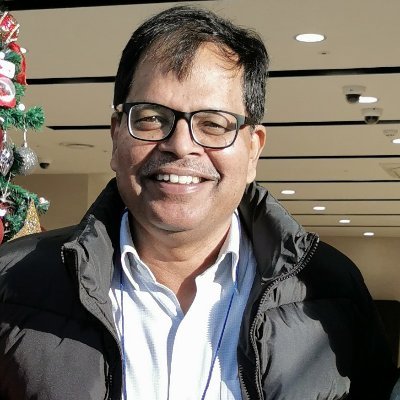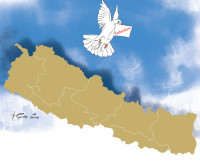Columns
Liquidity crisis
The sporadic efforts made are far too little compared to the magnitude of the water crisis..jpg&w=900&height=601)
Madhukar Upadhya
Aarati, an evening prayer performed at Hindu temples in which light is offered to the deities, is part of the daily rituals at the Ganga Sagar—one of the many holy ponds in the city of Janakpur. The aarati here is significant because devotees throng to the banks of the pond to listen to the systematic exposition of the importance of water, in the form of Ganga, that symbolises the power to purify. A message that stood out in the exposition provided by the priest was, ‘If you want to keep yourself clean, first, keep the water clean. We cannot make water, the least we can do is save it.’
Listening to the priest deliver such a powerful message was incredibly gratifying. It gave one a sense of awareness that the tradition of worshipping water bodies with aarati lights continues to teach us even today, in its own way, the value of water. Unfortunately, the dilapidated state of many water bodies in the area only demonstrates how the message remains abstract. The irony illustrates the failure on our part as far as protecting water bodies is concerned. Sadly, those with higher per capita water use often have the tendency to collect more than they need, generate more garbage and sewage, but, ultimately, do little to save water.
Tarai is the perfect place to learn about the changing nature of water problems as two systems—the rivers from the north and the groundwater systems extending south—overlap right here. The rage of the rivers flowing from the mountains begins to die down as soon as it reaches the plains of Tarai before heading towards the Ganges. Below the surface lies the vast reserve of groundwater of the Ganga basin to the south of this geography, which begins here.
On one hand, the changing conditions of the rivers in Tarai ceaselessly tell us about what is going on in the mountains. Disorganised development and indiscriminate, rampant exploitation of natural resources in the mountains in recent years have worsened the inherent character of the rivers—of carrying heavy sediment. It has increased siltation of the rivers, subsequently raising the river-beds to cause inundation over vast areas during the monsoon. Hundreds of seasonal rivers flowing from Chure have started to inundate previously safe areas.
On the other hand, the rapidly depleting groundwater illustrates the pressure exerted on it by an ever-increasing demand for water by millions of people including those across the border. The depletion has progressively advanced and we’ve reached new depths—literally. What used to be about 40-50 feet below the surface to access water just over two decades ago has now dropped to 400 to 500 feet in many places. But we’re going deeper still, and at a faster rate. More powerful water pumps are being installed to draw water from deeper aquifers as the shallow ones have dried. What’s concerning is that the rate of depletion will accelerate in the coming days, which will not only hurt those who rely on shallow pumps, but also on the ecosystems that depend on the availability of water in shallow aquifers.
Somehow, the fallout of the depleting groundwater and the increased siltation is connected with the increasing disconnection taking place between people and land (farms). Instead of farming, people look for alternate sources of income. It’s not surprising anymore to see the closure of many rice mills in the Tarai with lasting ramifications to the local and national economies.
The very definition of our water problem has changed over the years. In the past, the water problem was a matter of distance to the source; therefore, water projects laid pipes or put in pumps to connect people and settlements to the source. This has changed. Now, the problem is a loss of water at the source in many places.
Whether it is the drying up of streams or the depletion of groundwater, efforts of the required scale to revive the lost sources and see how they work, if at all, haven’t been put in place. Hitherto, the sporadic efforts made are far too little compared to the magnitude of the problem. In contrast, easier options of pumping from lower aquifers, which is bound to amplify the water problem in the future, have been promoted to meet the current water demand. As a result, we have lost the opportunity to gain the experience required in building confidence to manage water, which is essential to ensure the availability of water in the coming years. If water is available at the source today, it has more to do with nature’s resilience than any of our efforts.
We cannot shy away from the fact that the nature of the monsoon will continue to change with a warmer climate. If the scenario of rainfall and extreme events, as we witnessed in 2017 and 2019, are anything to go by, future conditions could be even more extreme. We can expect higher intensity rains coming in shorter periods, increasing widespread floods but reducing the chance for groundwater recharge. The conventional method of recharging groundwater using some scattered ponds is no longer sufficient: we need enhanced methods of recharge with twin targets: to compensate the loss of annual recharge caused by changed rainfall pattern, and to replenish the big drop we have created in the groundwater level over the years. Meeting these twin targets requires collective action on a massive scale carried out for several years.
The recent rainwater harvesting in India, which was named as Buldhana Pattern and was carried out on a large scale, is worth noting for the innovative approach to groundwater recharge employed by Indian officials. Road contractors were asked to collect soil and aggregates used in building roads from designated locations without paying a royalty. However, while doing so they would dig and widen vast areas, which would act as water harvesting structures. With this approach, the Indian government has been able to create vast recharge areas in drought-hit places without having to spend a single rupee on new, expensive, and high-stakes water-harvesting projects. The government doesn’t need to send water tankers to Buldhana area anymore as the lost local water sources have re-emerged.
Here is a lesson for us. By combining rampant, environmentally detrimental extraction of sand and gravel or even road construction with the creation of rainwater harvesting structures, we can achieve the enhanced recharge desperately needed to ensure water security in the days ahead. The lessons of our aarti and priests mustn’t remain abstract but find routine in the everyday.
***
What do you think?
Dear reader, we’d like to hear from you. We regularly publish letters to the editor on contemporary issues or direct responses to something the Post has recently published. Please send your letters to [email protected] with "Letter to the Editor" in the subject line. Please include your name, location, and a contact address so one of our editors can reach out to you.




 19.12°C Kathmandu
19.12°C Kathmandu

.jpg&w=200&height=120)











%20(1).jpg&w=300&height=200)

